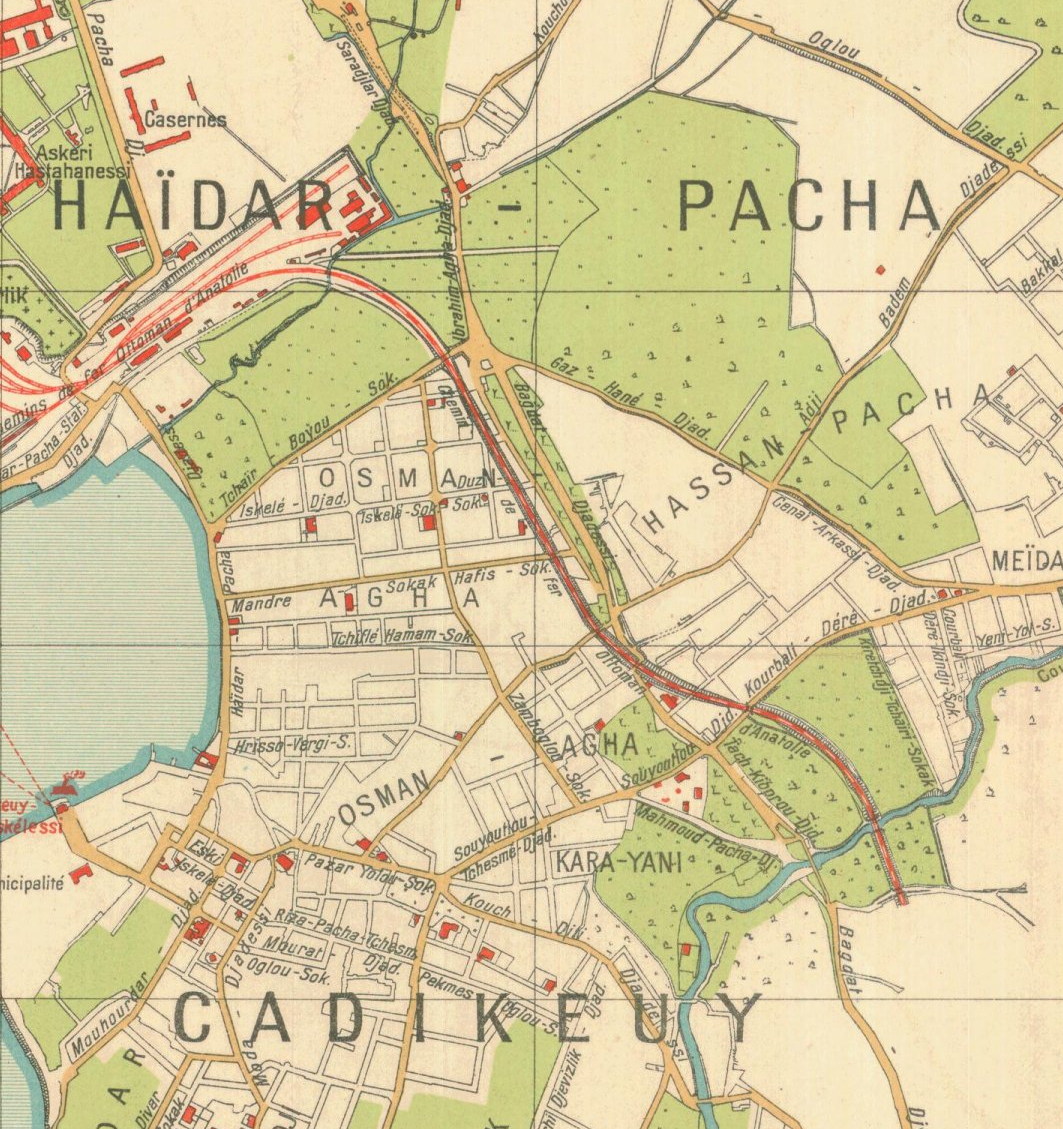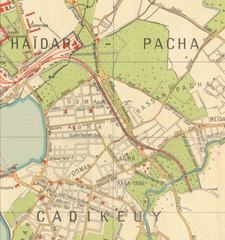
Bağdat Avenue Istanbul: Visiting Hours, Tickets, and Historical Sites Guide
Date: 14/06/2025
Introduction: Discover Bağdat Avenue, Istanbul’s Asian Side Gem
Bağdat Avenue (Bağdat Caddesi) is a celebrated and dynamic boulevard that stretches for 14–15 kilometers along Istanbul’s Asian side, connecting the vibrant districts of Kadıköy and Bostancı. With roots tracing back to the Byzantine and Ottoman eras, the avenue originally functioned as a critical trade and military corridor between Constantinople and Baghdad, immortalized by Sultan Murad IV’s 1638 conquest. Today, Bağdat Avenue is a bustling urban artery, renowned for its harmonious blend of historical architecture, luxury shopping, diverse dining, and a lively, cosmopolitan atmosphere.
Visitors can expect to explore a tapestry of elegant late Ottoman mansions, contemporary shopping centers, and characterful neighborhoods such as Suadiye, Moda, and Caddebostan. The avenue rivals Istiklal Street on the European side but offers a more relaxed, residential vibe, complemented by open-air concerts, art festivals, and family-friendly parks. Excellent public transport options, including metro lines, ferries, and buses, make the avenue readily accessible.
This guide explores Bağdat Avenue’s historical evolution, key attractions, shopping and dining highlights, practical travel tips, and answers to common visitor questions. For further details and travel inspiration, consult resources like IyiTurkey, Cab Istanbul, and Visit Turkey.
Table of Contents
- Introduction
- Historical Overview
- Architectural and Urban Heritage
- Cultural Significance and Social Life
- Economic and Social Impact
- Nearby Cultural Landmarks
- Visitor Information: Hours, Tickets, and Accessibility
- Transportation, Safety, and Travel Recommendations
- Special Events and Guided Tours
- Notable Photo Spots
- Frequently Asked Questions (FAQ)
- Conclusion and Practical Summary
- References
Historical Overview
Bağdat Avenue’s origins lie in the Byzantine and Ottoman periods, serving as a strategic route for commerce and military operations between Constantinople and Baghdad (iyiturkey.com; turckey.com). Its name commemorates Sultan Murad IV’s victory in Baghdad in 1638, and the avenue played a prominent role in Ottoman ceremonial processions and trade.
In the 19th and 20th centuries, the avenue underwent significant transformation, evolving from a dusty path into a fashionable boulevard lined with opulent mansions and grand residences. The introduction of tram lines and modern infrastructure further enhanced its status, making it a symbol of affluence and cosmopolitan living (thegreenvoyage.com).
Architectural and Urban Heritage
The urban fabric of Bağdat Avenue features a mosaic of late Ottoman mansions, early Republican buildings, and modern high-rises. Neighborhoods such as Suadiye and Caddebostan preserve restored mansions amidst new developments, offering a visual narrative of Istanbul’s evolving architectural landscape (iyiturkey.com; turckey.com).
Cultural Significance and Social Life
Bağdat Avenue is a cultural artery for Istanbulites, hosting open-air concerts, art exhibitions, street festivals, and national celebrations such as Republic Day. The avenue is a vibrant social hub, catering to families, professionals, and tourists seeking a taste of Istanbul’s diverse identity (iyiturkey.com; thegreenvoyage.com).
Economic and Social Impact
As a premier shopping destination, Bağdat Avenue is lined with luxury boutiques, international brands, and trendy local shops. The area has a robust property market, attracting local and international investors, while maintaining an inclusive atmosphere in its many cafes, restaurants, and public spaces (turckey.com; iyiturkey.com).
Nearby Cultural Landmarks
Bağdat Avenue’s location offers convenient access to several notable cultural sites:
- Moda: Bohemian neighborhood with art galleries and waterfront cafes.
- Caddebostan Beach: A popular spot for seaside relaxation.
- Kadıköy Bazaar: Authentic Turkish market experience (iyiturkey.com).
These sites enrich the avenue’s appeal, making it a gateway to the broader cultural landscape of Istanbul’s Asian side.
Visitor Information: Hours, Tickets, and Accessibility
- Visiting Hours: Bağdat Avenue is a public street, open 24/7. Most shops and cafes operate between 10:00 AM and 10:00 PM.
- Tickets: No entry tickets required for the avenue itself. Some attractions or guided tours may have separate fees.
- Best Times to Visit: Spring and autumn offer ideal weather; evenings are particularly lively.
- Accessibility: The avenue is pedestrian-friendly, with broad sidewalks and cycling paths. Some older sections may be less accessible for wheelchairs or strollers.
Transportation, Safety, and Travel Recommendations
Public Transport
- Metro: M4 Kadıköy-Tavşantepe line, with nearby stations such as Göztepe, Kozyatağı, and Bostancı (istanbulpoints.com).
- Marmaray: Connects European and Asian sides; Söğütlüçeşme and Bostancı stations are convenient.
- Buses/Minibuses: Several lines run parallel to or intersect Bağdat Avenue (asiapositive.com).
- Ferries: From Eminönü or Karaköy to Kadıköy or Bostancı (chasingthedonkey.com).
- Istanbulkart: Use this smart card for all public transport (asiapositive.com).
Taxis & Ride-Hailing
- Taxis are widely available; apps like BiTaksi and InDrive are recommended for fare transparency (istanbul.tips).
- Car hire is not recommended due to traffic and parking constraints (visitturkey.in).
Safety Tips
- Bağdat Avenue is considered one of Istanbul’s safest areas, but visitors should remain vigilant, especially during crowded events (chasingthedonkey.com).
- Be cautious of common scams and use designated crosswalks.
- In emergencies, dial 112; police stations and pharmacies are located nearby.
Practical Recommendations
- Best Times: Weekday mornings or early afternoons for a relaxed experience.
- Dress: Comfortable, flat shoes are advisable; dress modestly near mosques (istanbul.tips).
- Payments: Credit cards are widely accepted; carry cash for small purchases.
- Connectivity: Local SIM cards and free Wi-Fi in many venues (letsventureout.com).
- Dining/Shopping: Wide range of options; check menus and prices in advance, and bargain in smaller shops (istanbeautiful.com).
Special Events and Guided Tours
Bağdat Avenue is renowned for its seasonal festivals, parades, and open-air concerts, especially during spring and autumn. Guided walking tours focusing on history, architecture, or gastronomy are available from local tour operators. Check event calendars for the latest happenings.
Notable Photo Spots
- Caddebostan Beach: Sunset views and tree-lined promenades.
- Historic Mansions: Distinctive architecture along Suadiye and Caddebostan.
- Street Art: Urban murals and the nostalgic Kadıköy-Moda tram.
Key Attractions and Neighborhoods
Shopping and Boutiques
The avenue is Istanbul’s top destination for luxury brands (Louis Vuitton, Chanel, Tommy Hilfiger) and Turkish designers (Yargıcı, Ipekyol), alongside department stores like Beymen and Vakko (Cab Istanbul). Local artisan shops sell unique crafts and souvenirs.
Dining
From upscale establishments (Günaydın, Divan) to street food vendors and patisseries, Bağdat Avenue is a gastronomic hotspot.
Parks and Green Spaces
Tree-shaded sidewalks, urban parks, and the seaside promenade encourage leisure and recreation.
Nightlife
Nightlife flourishes with cocktail lounges, bars, and live music venues, particularly lively on weekends.
Notable Neighborhoods
- Kadıköy: Bustling cafés, art galleries, and the fish market (Lonely Planet).
- Moda: Trendy with cafes and independent shops (Istanbul Clues).
- Fenerbahçe: Elegant, with boutique stores and a scenic park.
- Caddebostan: Family-friendly, with a beach and cultural center (Visit Turkey).
- Bostancı: Transport hub with ferry access to the Princes’ Islands.
Frequently Asked Questions (FAQ)
Q: Is Bağdat Avenue open 24/7?
A: Yes, it is a public street open at all times; shops and restaurants generally operate from 10:00 AM to 10:00 PM.
Q: Do I need a ticket to visit?
A: No, the avenue is free to access. Specific attractions or tours may have their own fees.
Q: What is the best way to get there?
A: Public transportation—metro, Marmaray, buses, and ferries—offers the most convenient access.
Q: Is it safe for tourists and families?
A: Yes, Bağdat Avenue is one of Istanbul’s safest and most upscale areas.
Q: Are guided tours available?
A: Yes, several local operators offer history, shopping, and culinary tours.
Conclusion and Practical Summary
Bağdat Avenue embodies Istanbul’s unique blend of historical richness and modern vibrancy. Whether you are interested in shopping, gastronomy, cultural events, or simply enjoying the lively street life, the avenue offers a multifaceted experience. Its pedestrian-friendly design, excellent transport links, and array of attractions make it a must-visit destination for anyone exploring Istanbul’s Asian side.
For up-to-date information, local insights, and personalized travel recommendations, download the Audiala app and follow us on social media. Explore further with trusted guides like Istanbul Points, Chasing The Donkey, and Turkey.com.
References
- IyiTurkey: Bağdat Street (Bağdat Caddesi)
- Cab Istanbul: Visiting Guide, Attractions, and Social Life
- Chasing The Donkey: Transportation, Safety, and Practical Recommendations
- Turkey.com: Bağdat Avenue and Why It Was Named So
- Istanbul Points: Public Transport in Istanbul
- Visit Turkey: Bağdat Avenue, Istanbul
- Asia Positive: Public Transport Tickets and Fares
- Istanbul Clues: Best Neighborhoods in Istanbul
- Lonely Planet: Best Neighborhoods in Istanbul
- Istanbeautiful: Bağdat Street, Istanbul
- Lets Venture Out: Istanbul Travel Tips
- Istanbul Tips: Dos and Don’ts in Istanbul






















































































































